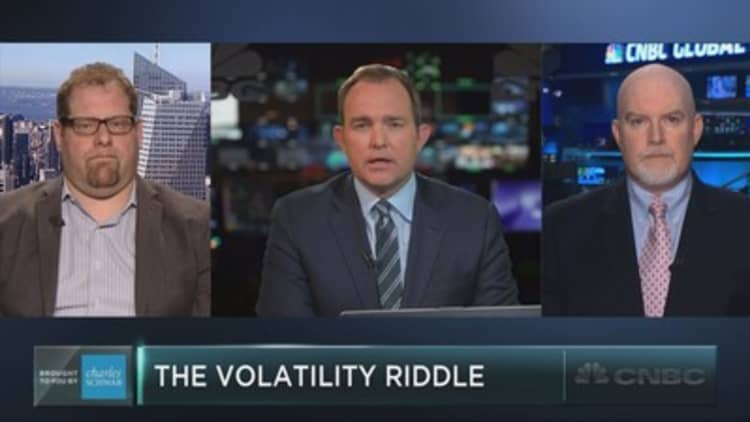
VIX spikes just aren't what they used to be.
The CBOE Volatility index, or VIX, hit a high of just under 12 early Thursday, its highest level in six weeks. While that may seem like an impressive move, it actually underscores what has been a historically mild year for volatility.
In fact, the index, known as the "fear gauge," hasn't traded up to its long-term average of about 19.4 once this year, and that has some market watchers debating whether it's a reliable tell of what's happening in the market anymore.
The VIX, which measures the market's anticipated volatility over a 30-day period using a range of S&P 500 options, at levels this low appears justified, said Dennis Davitt, portfolio manager and partner at Harvest Volatility Management. However, the way the indicator reflects implied volatility has shifted as new products around betting against volatility have gained popularity.
One of the factors behind low volatility is products built upon strategies that sell volatility into the markets, which are popular now, Davitt said, but they are "better capitalized with their volatility sales" than in the past. Such products could include the iPath S&P 500 VIX Short-Term Futures exchange-traded note, or the VXX.
Davitt said such products have distorted the VIX and to some degree have robbed the index of its effectiveness as a market barometer. And at this point, the market is "much more based on structure, market structure, than fundamentals. So using the VIX as an indicator whether or not to buy the market, I would say, is broken," he said.
"Right now, everyone is focusing on Korea and other macro risk that may be in the marketplace, but nobody is focusing on what's going right. I think people need to step back and take a look at what's going right in the marketplace," Davitt said Tuesday on CNBC's "Trading Nation."
Furthermore, volatility is "adding stability to the market, causing the market to move less, causing the VIX to go lower, causing those strategies to be more successful, so it synergistically builds on itself," Davitt added.
Max Wolff, chief economist at Disruptive Technology Advisors, agreed that the VIX has taken on somewhat of a different form than it once had.
While the index is still a good tell of the market's general attitude toward risk, it's become a "speculative object" that has pushed implied volatility to all-time lows this year, he explained. Indeed, the bull market has kicked into high gear this year as all major indices smashed through record highs. This as the VIX has remained at historic lows, seeing the most readings and closings under 10 on record.
"It's become a way to make money betting against volatility, which is something that's been very much rewarded in the market. So you have a big momentum trade betting against that volatility. What's sort of happened is this thing we try to use as an indicator, the VIX, has become the object of a speculative game, and that's pushed it down," he said Tuesday on "Trading Nation."
What that boils down to, Wolff said, is the index has now become "somewhere between a counterintuitive factor and a pretty weak factor in telling us what the actual riskiness of the market is."
In the short term, he doesn't see volatility picking up anytime soon despite geopolitical tensions arising globally. Markets are likely not as "passive" as the VIX reflects, he said, "but I do agree that there is a good reason for why it's low."





